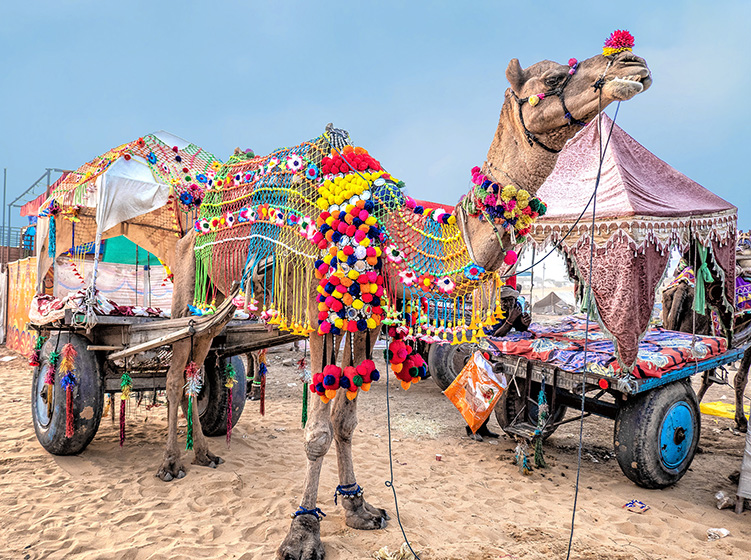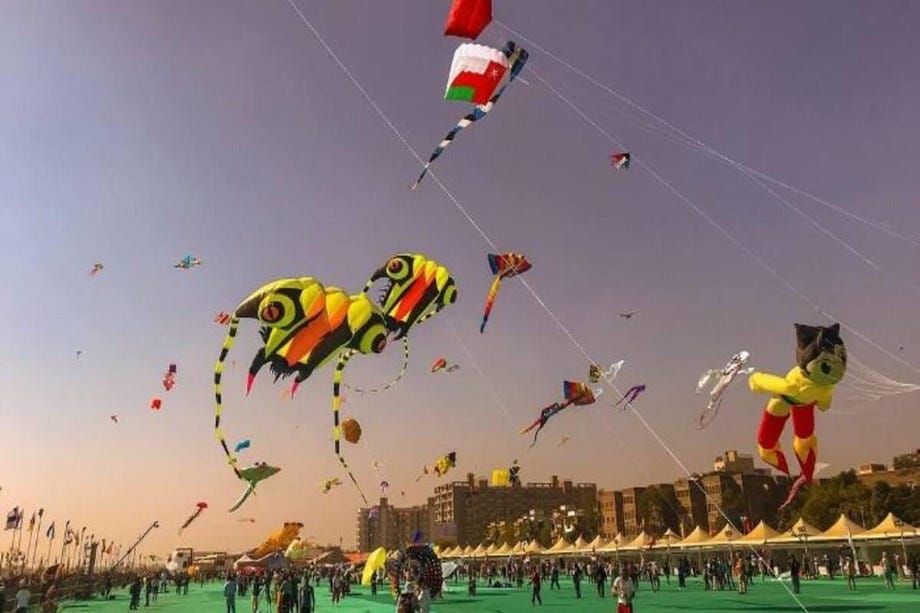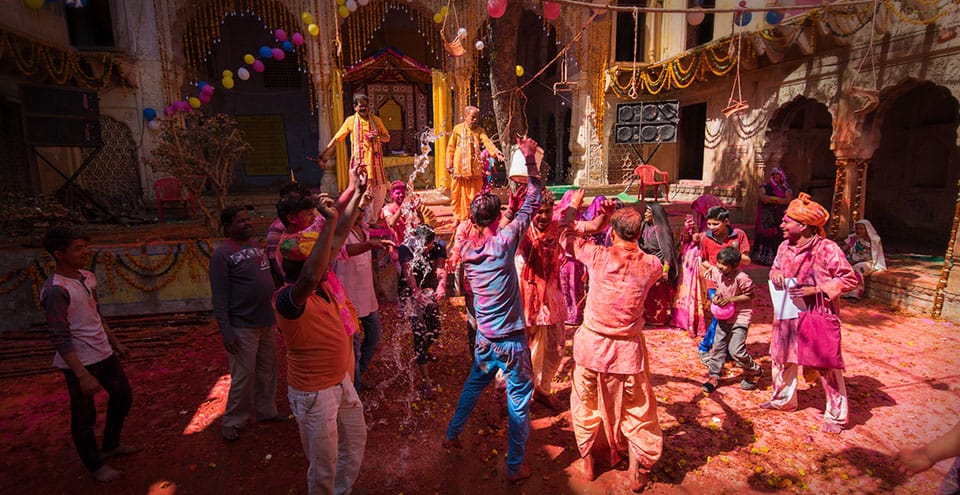Rajasthan, the land of kings, is known for its diverse cultural heritage and vibrant traditions. Among its many treasures, the melas (fairs) of Rajasthan stand out as a captivating reflection of the state’s diverse and colourful ethos. These melas are not merely events; they are an integral part of Rajasthan’s social fabric, offering a unique glimpse into its ancient customs, artistic expression, and communal spirit. From grand cattle fairs to spiritual congregations, the melas in Rajasthan are a celebration of life itself, drawing visitors from all over the world.
In this article, we discussed the 5 Famous Melas in Rajasthan, Famous Mela in Rajasthan, Famous fairs in Rajasthan, Rajasthan fair and festival, Camel fair in Rajasthan.
Pushkar Mela: The World's Largest Camel Fair
One of the most famous mela in Rajasthan is the Pushkar Mela, held annually in the sacred town of Pushkar. This fair is not only the largest camel fair in the world but also a major pilgrimage for Hindus. Held in the month of Kartik (October-November), the Pushkar Mela sees the convergence of over 200,000 people, including traders, pilgrims, and tourists.
A Spiritual Gathering
The Pushkar Mela coincides with the auspicious Kartik Purnima, a full moon day considered highly sacred by Hindus. Devotees from all over the country flock to Pushkar to take a dip in the holy Pushkar Lake, which is believed to absolve sins and bring salvation. The lake is surrounded by 52 ghats, each with its own significance, where pilgrims perform rituals and offer prayers.
The Camel Trade
At the heart of the Pushkar Mela is the camel trade. Traders from Rajasthan and neighbouring states bring their best camels to showcase and sell. The sight of thousands of camels, adorned with colourful bridles, beads, and mirrors, against the backdrop of the golden sands is a spectacle to behold. Apart from camels, horses and cattle are also traded, making this mela a hub for livestock trading.
Cultural Extravaganza
The Pushkar Mela is not just about trading camels; it’s a vibrant cultural festival. Folk performances, traditional music, and dance forms like Ghoomar and Kalbeliya add to the festive spirit. The mela also features competitions like camel races, moustache contests, and turban tying, which are crowd-pullers. Handicrafts, textiles, jewellery, and other traditional Rajasthani products are sold in the bustling bazaars, offering a shopping experience like no other.

Nagaur Cattle Fair: The Trading Hub of Rajasthan
Another significant mela in Rajasthan is the Nagaur Cattle Fair, held in the historic town of Nagaur. This fair is one of the largest cattle fairs in India and takes place in the month of January or February. The Nagaur Fair is primarily a livestock trading event, attracting traders from across the country.
The Cattle Market
The Nagaur Fair is renowned for its vast cattle market, where over 70,000 animals, including bullocks, camels, and horses, are bought and sold. The animals are beautifully decorated with colourful ornaments, and their owners take great pride in showcasing them. The fair also serves as a platform for farmers to exchange knowledge and discuss agricultural practices.
Cultural Celebrations
Like the Pushkar Mela, the Nagaur Fair is a cultural extravaganza. Traditional Rajasthani folk music and dance performances are a highlight, with local artists showcasing their talent. Competitions like tug-of-war, bullock cart races, and cockfights add to the excitement. The fairground is lined with stalls selling everything from spices to handicrafts, providing a sensory overload of sights, sounds, and smells.
Religious Significance
The Nagaur Fair also has a religious aspect, with devotees visiting the various temples in and around Nagaur. The Tarkeen Dargah, a revered Sufi shrine, sees a large number of visitors during the fair. Pilgrims offer prayers and seek blessings, adding a spiritual dimension to the otherwise bustling fair.
Also Read: Benefits of Renting a Luxury Car in India

Desert Festival: A Celebration of Rajasthan's Heritage
The Desert Festival of Jaisalmer is another iconic mela that showcases the best of Rajasthan’s cultural heritage. Held annually in the month of February, the Desert Festival is a three-day extravaganza that celebrates the traditions, art, and music of the Thar Desert.
A Cultural Showcase
The Desert Festival is a visual and auditory feast, with folk artists from across Rajasthan converging in Jaisalmer to perform. The rhythmic beats of traditional instruments like the dholak and khartal, combined with the soulful renditions of folk songs, create an enchanting atmosphere. The festival also features dance forms like Kalbeliya and Ghoomar, which are synonymous with Rajasthani culture.
Unique Competitions
One of the highlights of the Desert Festival is the unique competitions that are held, such as the Mr. Desert contest, turban tying, and best moustache competitions. These events celebrate the quintessential Rajasthani man, known for his elaborate turban and well-groomed moustache. The camel races and polo matches held during the festival are also major attractions.
A Vibrant Marketplace
The festival grounds are transformed into a vibrant marketplace, with stalls selling traditional Rajasthani handicrafts, textiles, and jewellery. The intricate craftsmanship of these products reflects the rich artisanal heritage of the region. Visitors can also sample authentic Rajasthani cuisine, with dishes like dal baati churma and gatte ki sabzi being local favorites.

Kite Festival: Soaring High in the Skies of Rajasthan
The Kite Festival of Rajasthan, celebrated on Makar Sankranti (14th January), is a unique mela that sees the skies of Rajasthan come alive with colourful kites. This festival is celebrated with great enthusiasm in Jaipur and other parts of the state.
The Joy of Kite Flying
The Kite Festival is all about the joy of kite flying, a tradition that dates back centuries. People of all ages take to rooftops and open spaces to fly kites, competing to cut down the kites of their opponents. The sky becomes a canvas of vibrant colors, with kites of all shapes and sizes soaring high.
A Festive Atmosphere
The festive atmosphere during the Kite Festival is palpable, with families and friends gathering to celebrate. The day is marked by special feasts, with til ke laddoo (sesame seed sweets) being a popular delicacy. In Jaipur, the festival is also marked by the International Kite Festival, which sees participants from across the globe showcasing their kite-flying skills.
Cultural Programs and Competitions
The Kite Festival is accompanied by cultural programs, including folk music and dance performances. Competitions for the best kite and kite-flying techniques are held, adding to the excitement. The festival is a beautiful blend of tradition, competition, and community spirit.

Brij Holi: A Vibrant Prelude to the Festival of Colors
The Brij Holi of Bharatpur is a unique mela that is celebrated a few days before the main festival of Holi. This mela is dedicated to Lord Krishna and is a vibrant celebration of colours, music, and dance.
A Devotional Celebration
Brij Holi is deeply rooted in the worship of Lord Krishna, with devotees gathering at the Radha Krishna temples to offer prayers and sing devotional songs. The town of Bharatpur comes alive with the sound of bhajans (devotional songs) and the sight of devotees dressed in vibrant colours.
Ras Leela Performances
One of the highlights of Brij Holi is the Ras Leela performances, which depict the divine love of Radha and Krishna. These performances are a visual delight, with dancers dressed in traditional attire enacting scenes from the life of Lord Krishna. The use of natural colours during the play of Holi adds to the authenticity of the experience.
A Riot of Colours
As with the main festival of Holi, the Brij Holi mela is marked by the playful throwing of colours. People smear each other with gulal (coloured powder) and splash water, creating a joyous atmosphere. The entire town is enveloped in a riot of colours, symbolising the arrival of spring and the victory of good over evil.

Conclusion: The Living Traditions of Rajasthan's Melas
The fairs of Rajasthan are a testimony to the rich cultural image of the state. Each mela, with its unique blend of tradition, religion, and festivity, offers a glimpse into the heart of Rajasthan. Be it the grandeur of the Pushkar Fair, the vibrancy of the Desert Festival, or the devotional fervour of Brij Holi, these fairs continue to attract tourists from far and wide, keeping the traditions of Rajasthan alive and thriving.


